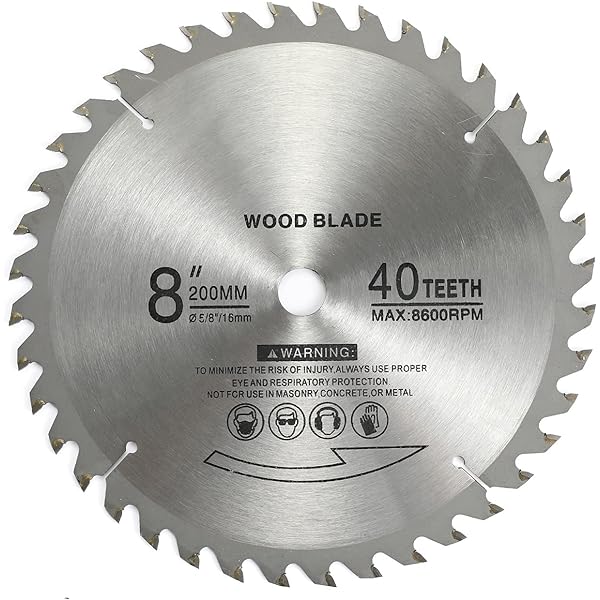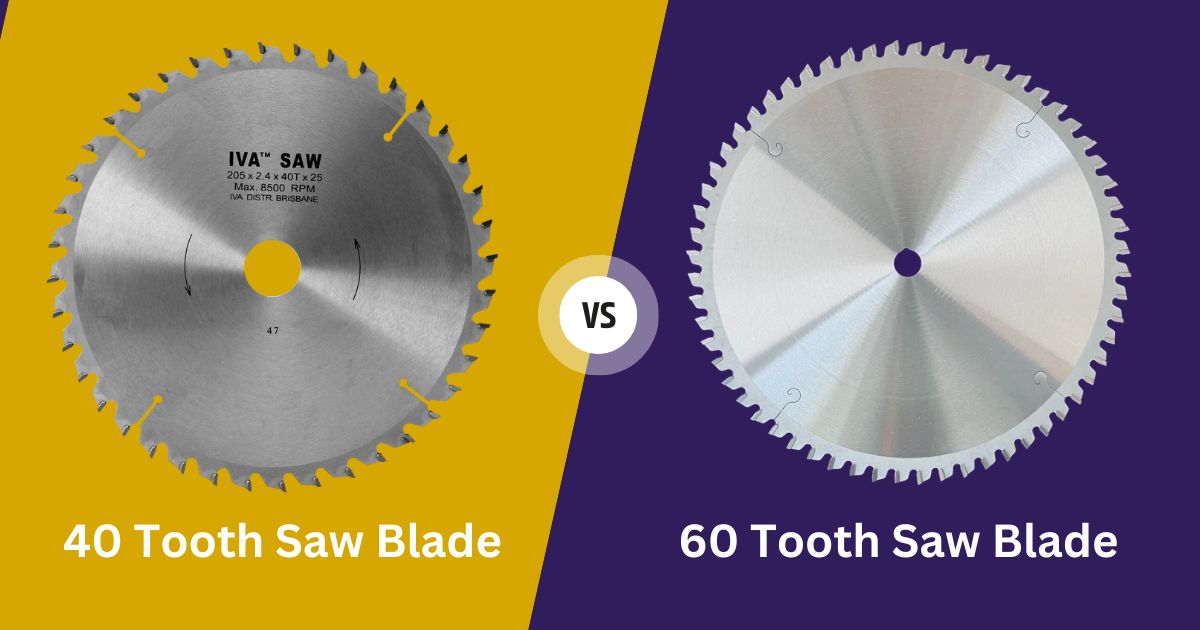Circular saw blades offer a variety of tooth counts, ranging from 14 to 120 teeth, each suitable for specific tasks. Choosing the right blade is crucial for achieving clean cuts.
Factors like the material, its thickness, and the grain direction relative to the sawblade influence the ideal tooth count. The primary consideration is the desired outcome; blades with fewer teeth cut faster but yield rougher results, suitable for framing.
Conversely, higher tooth counts provide a smoother cut, crucial for cabinetmakers, although the cut may be slower. This discussion delves into the distinctions between 40 tooth vs 60 tooth saw blade.
These principles generally apply to most saw blades, though variations exist among blades used with different tools. This article will address those distinctions to provide a comprehensive understanding.
Selecting the Appropriate Saw Blade:
Usually, when cutting wood, you’ll need to make both cross-grain and with-grain cuts, calling for a versatile combo saw blade. Opt for a rip saw blade for cuts along the grain and a crosscut saw blade for perpendicular cuts.
Using blades specifically designed for each cut type—crosscut or rip—offers advantages like smoother, faster, and more durable cuts.
For repetitive tasks, like framing with 2x4s, a crosscut blade saves time and money. If your project involves both cut types, a combo blade is more practical than switching between rip and crosscut blades.
If you’re uncertain about the cutting you’ll be doing or plan to do both ripping and crosscutting, go for a combination (general-purpose) blade.
These blades, also known as general-purpose, strike a balance with more teeth than ripping blades and fewer than crosscut blades, making them suitable for various tasks.
What Does Tooth Count Means:
A saw blade is made up of teeth that do the cutting work. The number of teeth varies based on factors like how you’ll use the blade—whether for ripping or crosscutting. Ripping, cutting along the wood grain, needs fewer teeth than crosscutting, which involves cutting across the grain.
If you’re unsure about the cutting task or plan to do both ripping and crosscutting, a combination blade (also called general-purpose) is the right pick. It has more teeth than a ripping blade but fewer than a crosscutting one, making it versatile for both types of cuts.
How Many Teeth Are Needed for Ripping Wood?
The functionality of a saw blade is dictated by the number of teeth it possesses. Saw blades tailored for rip-cutting, slicing through the wood grain along the board’s length, typically have a lower tooth count, ranging between 16 and 40.
These teeth are designed for aggressive cutting, featuring deep gullets that aid efficient chip removal. The wider spacing between teeth, known as the gullet, facilitates swift and easy ripping across various wood types.
Blades with a lower tooth count are sturdier and more efficient for uncomplicated wood ripping compared to those with a higher count.
It’s crucial to recognize that the number of blade teeth influences the type of cut, finishing, and cutting speed. Using an inappropriate blade can be laborious, time-consuming, and result in subpar work.
Many 40-tooth miter saw blades, ideal for wood ripping, come with expansion slots that cut into the trim, preventing warping during contraction and expansion while reducing vibration for precise and straight cuts.
For enhanced efficiency, precision, and accuracy, it’s advisable to match the miter saw blade to the intended function. Lower tooth count blades are tailored for rough and aggressive ripping and cutting, while higher tooth count miter saw blades are perfect for smooth and clean cuts.
The 40-tooth miter saw blade, for instance, is well-suited for quick 2×4 frame cuttings where smoothness is not a priority.
What Is the Purpose of a 40-Tooth Blade?

A 40-tooth blade serves as a versatile tool, ideal for various woodworking applications. Its primary purpose is to cut materials like oak, pine, plywood, pressure-treated lumber, and beams.
Well-suited for table and miter saws, this blade ensures smooth cuts in different tasks, eliminating the need for frequent blade changes. The moderate tooth count strikes a balance, making it effective for general-purpose use.
It excels in providing clean and efficient cuts, particularly in applications where a finer finish might not be the top priority. Overall, the 40-tooth blade is a reliable choice for woodworkers, offering efficiency and convenience in a range of common cutting tasks.
What Is the Purpose of a 60-Tooth Blade?

A 60-tooth blade serves a distinct purpose in woodworking, excelling in finer and more delicate cutting tasks. Specifically designed for precision, this blade is your go-to tool for slicing through materials like oak, pine, melamine, veneer plywood, and delicate molding.
Its higher tooth count minimizes the grabbing of the workpiece, resulting in smoother cuts that often require little to no additional sanding. This makes the 60-tooth blade particularly suitable for applications where a fine finish is crucial.
Whether you’re working on intricate woodwork or projects demanding a polished outcome, the 60-tooth blade proves invaluable, providing both accuracy and a smoother surface in various woodworking scenarios.
Choosing the Suitable Blade for Different Cuts: 40 Tooth vs 60 Tooth Table Saw Blade:

In woodworking, there are two main cuts: the crosscut, going across the grain, and the rip cut, going along the grain.
Crafting a clean crosscut is challenging as it involves severing wood fibers and cutting through the binding lignin.
Higher tooth count blades, whether overall or per inch (TPI), work better for cross-cutting materials like plywood and laminate, which tend to tear and chip easily. For plywood, we recommend a 40-tooth blade or higher, and for laminate, an 80-tooth blade.
Since a miter saw is designed for cross-cutting, we prefer using a 40-tooth blade or higher, with a personal preference for a 60-tooth blade.
Conversely, a rip cut is simpler, involving the separation of fibers without completely cutting through them. Depending on the wood piece, some fibers might be cut.
To prevent heat buildup, the blade should have a lower tooth count or a lower TPI with deeper gullets to efficiently remove sawdust from the kerf. For rip cuts on the table saw, we use a 24-tooth blade.
When using a circular saw for plywood, we opt for a 60-tooth blade to achieve a clean cut. For rougher tasks like cutting studs or making long rip cuts in solid wood, we may consider using a 40 or even a 20-tooth blade.
Jigsaw and bandsaw blades require additional considerations due to their ability to cut curves. Wider blades may struggle with curves, as seen with the scroll blade for the jigsaw, which is about half as wide as other blades.
We have bandsaw blades designed for rough milling, featuring width for stability and strength, leaving a rough surface for this purpose. On the other hand, narrower bandsaw blades with higher TPI are multi-purpose, excelling in cutting curves and providing a smoother overall finish.
Jigsaw blades exhibit similar characteristics but on a smaller scale. Wider blades with low TPI cut faster, while blades for finishing have a higher TPI. Blades are labeled based on their intended application.
To summarize and offer practical advice:
For beginners, a 60-tooth crosscut blade for the miter saw and a 40-tooth combination blade for the circular saw is recommended. This setup allows for excellent crosscuts and clean plywood breakdown.
If there’s a future need to rip solid wood with the circular saw, consider a 20 or 24-tooth blade. However, it’s wise to wait until the actual need arises to avoid unnecessary spending.
As skills develop, and more projects are undertaken, especially with the addition of a table saw, consider expanding the blade collection. Add a 24-tooth rip blade and a 40-tooth combination blade. Later on, explore dado blades.
For portable table saws, opt for thin kerf blades. While a portable table saw usually comes with one, we recommend replacing it with a thin kerf blade.
For cabinet or hybrid table saws, use full kerf blades for increased accuracy and consistency. If issues arise, such as an underpowered or aging motor, consider switching to a thin kerf blade.
Bottom Line: 40 Tooth vs 60 Tooth Saw Blade
In conclusion, choosing between a 40 vs 60 tooth saw blades ultimately depends on the nature of your woodworking projects. The 40-tooth blade, with its moderate tooth count, proves to be a versatile workhorse, excelling in general-purpose tasks such as cutting oak, pine, plywood, and pressure-treated lumber. Its efficiency, combined with the convenience of minimizing blade changes, makes it a reliable choice for various applications.
On the other hand, the 60-tooth blade specializes in delivering precision and a smoother finish. It becomes the craftsman’s weapon of choice when working with materials like oak, pine, melamine, veneer plywood, and delicate molding.
The higher tooth count minimizes workpiece grabbing, resulting in clean cuts that often require minimal post-cut sanding. For projects demanding a more polished outcome or intricate woodwork, the 60-tooth blade emerges as the go-to option.
In essence, whether you lean towards the versatility of the 40-tooth blade or the precision of the 60-tooth blade, understanding the specific demands of your woodworking tasks will guide you to the best-suited table saw blade for achieving optimal results in your craft.
FAQs
What’s the Distinction Between 60 Tooth vs 40 Tooth Saw Blade?
A 40-tooth blade is suitable for most plywood cuts. For veneered plywood and melamine, which are prone to tear out on the underside, especially with thin veneers, it’s recommended to use blades with 60 or 80 teeth. Achieving the cleanest cut on MDF requires even more teeth, ranging from 90 to 120.
What Do You Use a 40-tooth Saw Blade For?
A 40-tooth saw blade, like Diablo’s general-purpose blade, is perfect for cutting materials such as oak, pine, plywood, pressure-treated lumber, and beams. It works well with table and miter saws, leaving a smooth cut in various applications. This blade is a great choice as it minimizes the need to switch between blades for different tasks.
What is the Purpose of a 60-tooth Saw Blade?
The Diablo by Freud D1060X 10″ x 60 Tooth Fine Finish Saw Blade is designed for smoothly cutting oak, pine, melamine, veneer plywood, and delicate molding. With its high tooth count, it reduces workpiece grabbing, resulting in cuts that need minimal or no sanding.
Related Posts:
- Radial Arm Saw vs Table Saw
- 24 vs 40 Tooth Saw Blade
- Ryobi P325 vs P326: A Comprehensive Comparison
- Arbor Saw vs Table Saw
- Craftsman vs Ryobi Table Saw
- Delta vs Dewalt Table Saw: (Which One is Better)
- Table Saw vs Track Saw: (4 Main Keys Difference)
- Bosch vs Dewalt Table Saw: Which One is Better?
- Table Saw vs Band Saw: Which One Is Better?
- Cabinet Saw vs Table Saw






